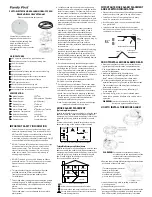
128-9110
4 of 12
The
blue wire
provides the first ground pulse during disarming, or the
drivers door pulsed ground unlock
output. Connect the
blue wire to the
drivers door unlock
relay that requires a low current ground signal to unlock only the drivers door. If the vehicle
does not have a separate drivers door relay, one will have to be added. Locate the drivers door unlock motor wire and cut it at a
convenient location to allow wiring of an optional relay. Connect the door side of the cut wire to terminal 30 of the optional relay
added. Connect the vehicle side of the cut wire to terminal 87a of the optional relay added. Connect the blue wire of the 3 pin
harness to terminal 86 of the optional relay added. Connect terminal 85 of the optional relay added to a fused co 12 volt
source. Most vehicles door lock/unlock motor legs rest at ground, and 12 volts to the door lock/unlock motor legs for
operation, if this is the case in the vehicle you are working on, connect the remaining terminal, 87, to a fused + 12 volt source. In
the rare instance that the vehicle door lock/unlock motor legs rest at + 12 volts and switches ground to the door lock/unlock motors,
connect he remaining terminal, 87, to chassis ground.
The
Blue/Green wire
provides a pulse ground output when the unlock button of the transmitter is pressed a second time after
disarming. Connect the Blue/Green wire to the wire that provides a low current ground signal from the factory door unlock switch
to the factory door lock control relay.
Resistive Circuits, As Well As 4 Wire Polarity Reversal and 5 Wire Alternating 12 Volt
Door Lock Control Circuits
These applications require the use of additional components which may include relays, fixed resistors, or for convenience, the AS
9159a Door Lock Interface. Refer to the AUDIOVOX Door Lock Wiring Supplement and or the Audiovox fax back service for
information on your particular vehicle for properly connecting to these types of circuits.
COMPLETING THE INSTALLATION
NOTE:
This unit has the ability to learn the dome light delay time, up to 60 seconds. If the vehicle has delay interior lights, and you
wish to avoid three chirp, defect zone, indication normally associated with this type of interior light, we suggest you learn the
interior light delay.
To learn the light delay, start with all doors closed:
(1) Use the transmitter to Lock / Unlock / Lock / Unlock / Lock / Unlock / Lock, the system.
The LED turns on solid to confirm the system entered the learn mode.
(2) Immediately open and close the door of the vehicle to initiate the dome delay.
The unit will monitor the door trigger input Positive, (Purple), and Negative, (Green) when active.
When the dome light turns off, the unit will add 2 seconds then exit the learn mode.
(3) The LED will begin flashing the Armed indication indicating the unit has exited the learn mode and is armed.
Adjusting the Shock Sensor:
If used, the sensitivity of the pre-detect circuit is automatically set 30% less sensitive than the full
trigger circuit.
Using a small screwdriver, gently turn the adjustment screw fully counterclockwise. (
DO NOT
over turn this screw. Maximum
rotation for this adjustment is 270°). Close the hood and trunk lids, and arm the alarm. Wait 6 seconds for the accessories trigger
zone to stabilize, then firmly strike the rear bumper with the side of a closed fist considering the amount of force required to break
a window.
CAUTION: Never perform this test on the vehicle’s glass, as you may break the window.
Turn the adjustment screw clockwise (increasing sensitivity) about ¼ turn and re-test. Repeat this procedure until the alarm
sounds. Ultimately, one firm strike to the rear bumper will cause the alarm to emit pre-detect warning tones.
CAUTION:
Setting the sensitivity too high can cause false alarms due to noise vibrations from passing trucks and heavy equipment.
To decrease sensitivity, turn the adjustment screw counter clockwise.
Wire Dressing:
Always wrap the alarm wires in convoluted tubing, or with a spiral wrap of electrical tape. Secure these looms
along the routing using cable ties. This will ensure that the alarm wires are not damaged by falling onto hot or sharp moving surfaces
in the vehicle.
Operation:
Take a few moments to check off the appropriate option boxes in the owner’s manual, and to fully explain the operation
of the system to your customer.
Page 4
FCC NOTICE
This device complies with part 15 of the FCC rules. Operation of this device is subject to the following conditions:
(1) This device may not cause harmful interference, and
(2) This device must accept any interference received, including interference that may cause undesired operation.
Caution: Changes or modifications not expressly approved by the party responsible for compliance voids the users authority to
operate this device.






























